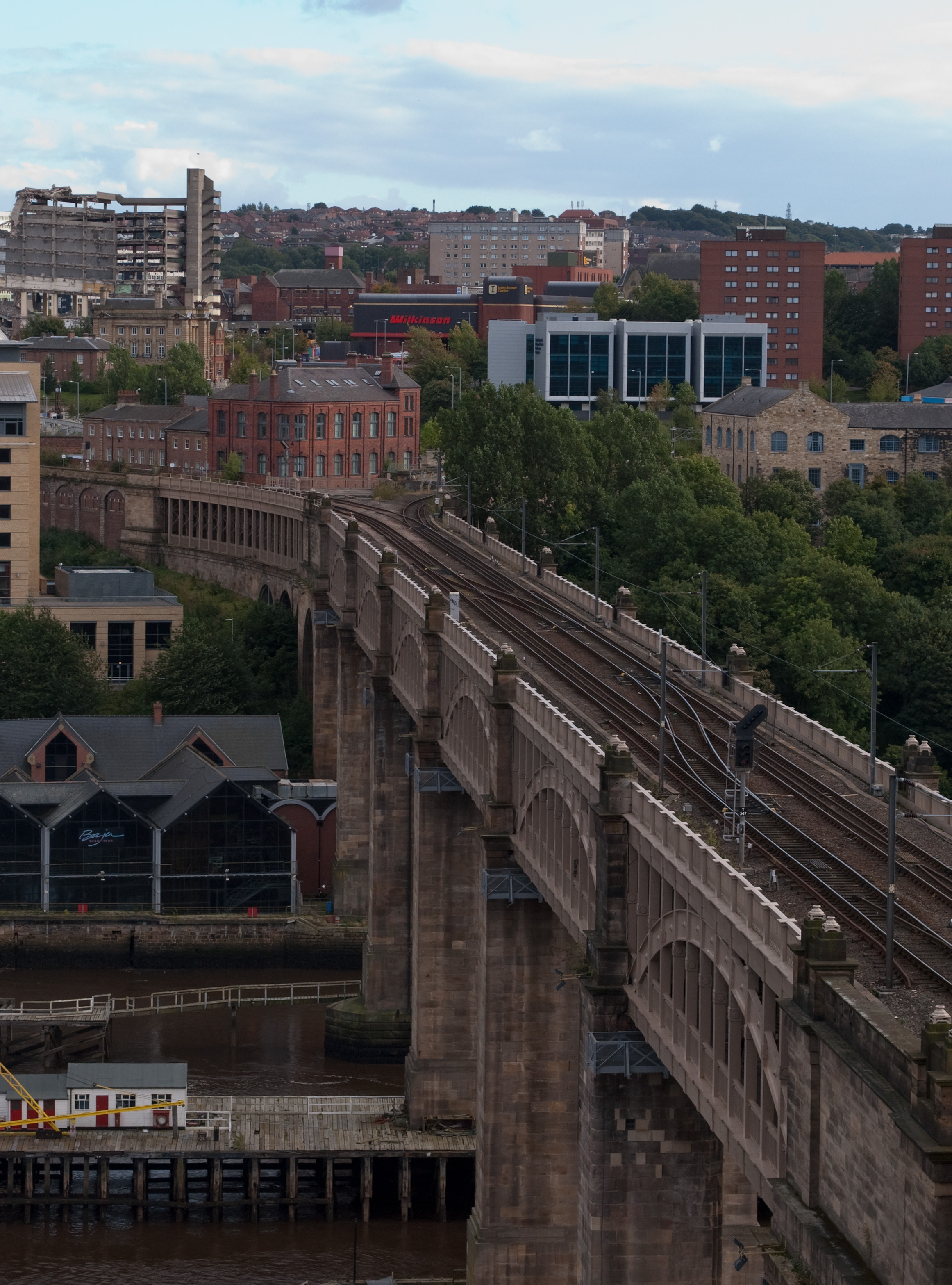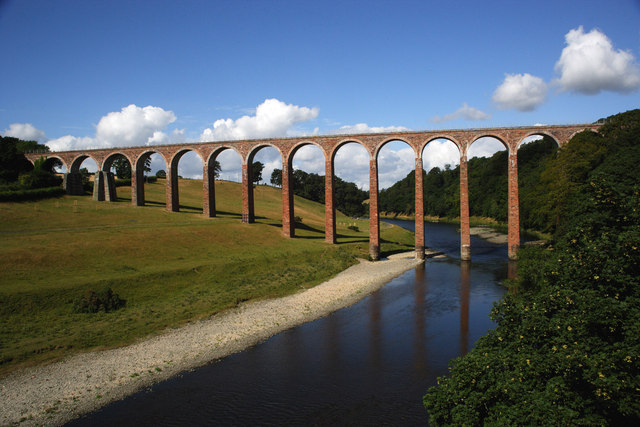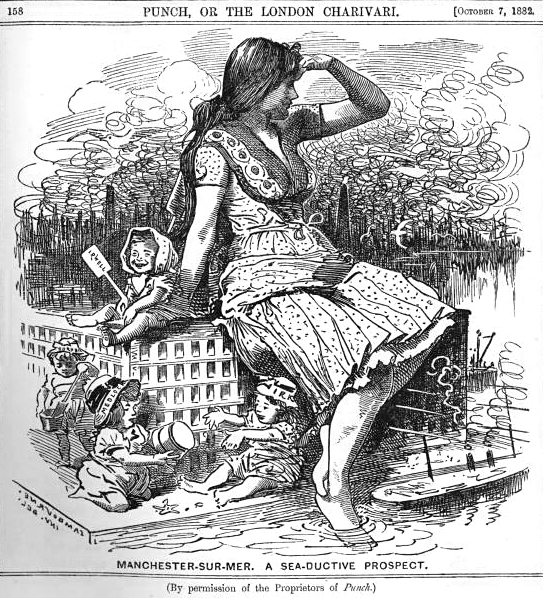|
Conisbrough Viaduct
Conisbrough Viaduct is a former railway viaduct, near to Cadeby and Conisbrough in South Yorkshire, England. The viaduct consists of two sections of brick and stone on each bank, connected by a lattice girder section, some over the River Don. The height and space were required should shipping need to navigate along the river. The viaduct carried the Dearne Valley Railway over the River Don between 1909 and 1966, after closure it was converted into a foot and cycle path. The structure is grade II listed, and is notable for being one of the first bridges in Britain to be built using a rope system above the viaduct known as a "Blondin". The viaduct was west of Edlington Halt, and south of Crofton Junction. History The viaduct connected the Dearne Valley Railway and its associated collieries with Black Carr and Doncaster in the south. The Act of Parliament was approved in 1897. The railway opened in stages, from 1902 onwards, with the final section of trackwork being completed ... [...More Info...] [...Related Items...] OR: [Wikipedia] [Google] [Baidu] |
River Don, Yorkshire
The River Don (also called River Dun in some stretches) is a river in South Yorkshire and the East Riding of Yorkshire, England. It rises in the Pennines, west of Dunford Bridge, and flows for eastwards, through the Don Valley, via Penistone, Sheffield, Rotherham, Mexborough, Conisbrough, Doncaster and Stainforth. It originally joined the Trent, but was re-engineered by Cornelius Vermuyden as the ''Dutch River'' in the 1620s, and now joins the River Ouse at Goole. Don Valley is a UK parliamentary constituency near the Doncaster stretch of the river. Etymology The probable origin of the name was Brittonic ''Dānā'', from a root ''dān-'', meaning "water" or "river". The name Dôn (or Danu), a Celtic mother goddess, has the same origin. The river gave its name to the Don River, one of the principal rivers of Toronto, Canada. Geography The Don can be divided into sections by the different types of structures built to restrict its passage. The upper reaches, and those of ... [...More Info...] [...Related Items...] OR: [Wikipedia] [Google] [Baidu] |
High Level Bridge, River Tyne
The High Level Bridge is a road and railway bridge spanning the River Tyne between Newcastle upon Tyne and Gateshead in North East England. It is considered the most notable historical engineering work in the city.M F Barbey, ''Civil Engineering Heritage: Northern England'', Thomas Telford Publishing, London, 1986, It was built by the Hawks family from 5,050tons of iron. George Hawks, Mayor of Gateshead, drove in the last key of the structure on 7 June 1849, and the bridge was officially opened by Queen Victoria later that year. It was designed by Robert Stephenson to form a rail link towards Scotland for the developing English railway network; a carriageway for road vehicles and pedestrians was incorporated to generate additional revenue. The main structural elements are tied cast-iron arches. Notwithstanding the considerable increase in the weight of railway vehicles since it was designed, it continues to carry rail traffic, although the King Edward bridge nearby was op ... [...More Info...] [...Related Items...] OR: [Wikipedia] [Google] [Baidu] |
Railway Viaducts In South Yorkshire
Rail transport (also known as train transport) is a means of transport that transfers passengers and goods on wheeled vehicles running on rails, which are incorporated in Track (rail transport), tracks. In contrast to road transport, where the vehicles run on a prepared flat surface, rail vehicles (rolling stock) are directionally guided by the tracks on which they run. Tracks usually consist of steel rails, installed on Railroad tie, sleepers (ties) set in track ballast, ballast, on which the rolling stock, usually fitted with metal wheels, moves. Other variations are also possible, such as "slab track", in which the rails are fastened to a concrete foundation resting on a prepared subsurface. Rolling stock in a rail transport system generally encounters lower friction, frictional resistance than rubber-tyred road vehicles, so passenger and freight cars (carriages and wagons) can be coupled into longer trains. The rail transport operations, operation is carried out by a ... [...More Info...] [...Related Items...] OR: [Wikipedia] [Google] [Baidu] |
Buildings And Structures In The Metropolitan Borough Of Doncaster
A building, or edifice, is an enclosed structure with a roof and walls standing more or less permanently in one place, such as a house or factory (although there's also portable buildings). Buildings come in a variety of sizes, shapes, and functions, and have been adapted throughout history for a wide number of factors, from building materials available, to weather conditions, land prices, ground conditions, specific uses, prestige, and aesthetic reasons. To better understand the term ''building'' compare the list of nonbuilding structures. Buildings serve several societal needs – primarily as shelter from weather, security, living space, privacy, to store belongings, and to comfortably live and work. A building as a shelter represents a physical division of the human habitat (a place of comfort and safety) and the ''outside'' (a place that at times may be harsh and harmful). Ever since the first cave paintings, buildings have also become objects or canvasses of much artistic ... [...More Info...] [...Related Items...] OR: [Wikipedia] [Google] [Baidu] |
Listed Buildings In Conisbrough And Denaby
Conisbrough is a ward and Denaby is a civil parish in the metropolitan borough of Doncaster, South Yorkshire, England. The ward and parish contain 18 listed buildings that are recorded in the National Heritage List for England. Of these, two are listed at Grade I, the highest of the three grades, and the others are at Grade II, the lowest grade. The listed buildings are in the town of Conisbrough, and the villages of Denaby Main and Old Denaby. The most important buildings are Conisbrough Castle and St Peter's Church, both listed at Grade I. The other listed buildings include houses, a medieval well cover, a set of stocks, a public house, a railway station and station house, a railway viaduct, two mileposts, another church and a chapel, a drinking fountain, and two war memorials. __NOTOC__ Key Buildings References Citations Sources * * * * * * * * * * * * * * * * * * * * {{DEFAULTSORT:Conisbrough and Denaby Lists of listed buildings in South ... [...More Info...] [...Related Items...] OR: [Wikipedia] [Google] [Baidu] |
DCI Banks
''DCI Banks'' is a British television crime drama series produced by Left Bank Pictures for the ITV network. Originally broadcast over five series in 2010–2016, the series was based on Peter Robinson's Inspector Alan Banks novels and stars Stephen Tompkinson as Detective Chief Inspector Alan Banks. In 2013, the series won in the drama category at the regional Royal Television Society Yorkshire Programme Awards. Background In January 2010, author Peter Robinson signed with Left Bank Pictures and ITV to adapt novels from the Detective Chief Inspector Alan Banks series for television. Filming on a two-part pilot based on ''Aftermath'' was completed in July 2010, with scenes filmed in Leeds. ''DCI Banks: Aftermath'' was broadcast on ITV on 27 September and 4 October 2010. The two episodes drew 6.55 million viewers, twice becoming the fifth most-watched programme on the ITV network that week. ITV commissioned six episodesthree two-part dramas adapted from three novels for th ... [...More Info...] [...Related Items...] OR: [Wikipedia] [Google] [Baidu] |
Sustrans
Sustrans is a United Kingdom-based walking, wheeling and cycling charity, and the custodian of the National Cycle Network. Its flagship project is the National Cycle Network, which has created of signed cycle routes throughout the United Kingdom including of traffic-free paths. The rest of the network is on previously existing and mostly minor roads, in which motor traffic will be encountered. Sustrans works with schools to encourage active travel (cycling, walking or scooting) among students. It also works with employers and local authorities. It administers several thousand volunteers who contribute their time to the charity in numerous ways, such as cleaning and maintaining the National Cycle Network, enhancing biodiversity along the routes, leading walks and rides and supporting communities to improve their air quality. In Scotland, Sustrans has established partnership teams, embedding officers in local councils as well as NHS Scotland, the Scottish Environment Protecti ... [...More Info...] [...Related Items...] OR: [Wikipedia] [Google] [Baidu] |
British Railways Board (Residuary)
BRB (Residuary) LimitedCompanies House extract company no 4146505 BRB (Residuary) Limited (BRBR) was the successor to the . It was created in 2001 as a , with 100% of the issued share capital owned by the . As part of the |
Stanningley
Stanningley is a district of Pudsey, West Yorkshire, England. It is situated approximately west of Leeds city centre on the A647 road, the original main road from Leeds to Bradford. The appropriate Leeds Metropolitan Ward is Bramley, Leeds, Bramley and Stanningley. The parish is part of the Anglican Diocese of Leeds. History The parish church of St Thomas was built in 1841 in Neo-Norman architecture, Neo-Norman style and is now Listed building, Grade II listed. It was designed by H. Rogerson. The foundation stone was laid on 5 November 1839, by John Farrar of Pudsey. The organ chamber and vestry were added in 1870. There are examples of stained glass dating to the 1860s and painted panels from the late 1880s. There is a notable marble memorial to John Butler of Windhill and Wrose, West Royd, d.1884 which was erected by the men of the Stanningley Ironworks where he was the manager. St Paul's Parish Church was constructed in 1853 and its Parish register, register started in 1 ... [...More Info...] [...Related Items...] OR: [Wikipedia] [Google] [Baidu] |
Manchester Ship Canal
The Manchester Ship Canal is a inland waterway in the North West of England linking Manchester to the Irish Sea. Starting at the Mersey Estuary at Eastham, near Ellesmere Port, Cheshire, it generally follows the original routes of the rivers Mersey and Irwell through the historic counties of Cheshire and Lancashire. Several sets of locks lift vessels about to the canal's terminus in Manchester. Landmarks along its route include the Barton Swing Aqueduct, the world's only swing aqueduct, and Trafford Park, the world's first planned industrial estate and still the largest in Europe. The rivers Mersey and Irwell were first made navigable in the early 18th century. Goods were also transported on the Runcorn extension of the Bridgewater Canal (from 1776) and the Liverpool and Manchester Railway (from 1830), but by the late 19th century the Mersey and Irwell Navigation had fallen into disrepair and was often unusable. In addition, Manchester's business community viewed the cha ... [...More Info...] [...Related Items...] OR: [Wikipedia] [Google] [Baidu] |
Sheffield
Sheffield is a city status in the United Kingdom, city in South Yorkshire, England, whose name derives from the River Sheaf which runs through it. The city serves as the administrative centre of the City of Sheffield. It is Historic counties of England, historically part of the West Riding of Yorkshire and some of its southern suburbs were transferred from Derbyshire to the city council. It is the largest settlement in South Yorkshire. The city is in the eastern foothills of the Pennines and the valleys of the River Don, Yorkshire, River Don with its four tributaries: the River Loxley, Loxley, the Porter Brook, the River Rivelin, Rivelin and the River Sheaf, Sheaf. Sixty-one per cent of Sheffield's entire area is green space and a third of the city lies within the Peak District national park. There are more than 250 parks, woodlands and gardens in the city, which is estimated to contain around 4.5 million trees. The city is south of Leeds, east of Manchester, and north ... [...More Info...] [...Related Items...] OR: [Wikipedia] [Google] [Baidu] |
Leighton Reservoir
Leighton Reservoir is a reservoir which drains via the River Burn to the River Ure in North Yorkshire, England. It neighbours Roundhill Reservoir and is about west of Masham. It takes its name from the nearby village of Leighton. Work on the reservoir was started by the Leeds Corporation in 1908, and although the major parts of the building process were over by March 1926, the final cementation was not completed until 1941. The reservoir was allowed to fill with water over the winter of 1926–1927. A newspaper report from 1910, estimated that the final cost of the construction would be £437,000 (). Although the Leeds Corporation intended to build another reservoir in Colsterdale on the River Burn, this never came to pass, and Leighton Reservoir was constructed on two tributaries of the Burn; Pott Beck and Spruce Gell. Water from the reservoir is used to compensate for abstraction from the River Ure. Although not in Nidderdale, the reservoir is within the Nidderdale Area o ... [...More Info...] [...Related Items...] OR: [Wikipedia] [Google] [Baidu] |






.jpg)

